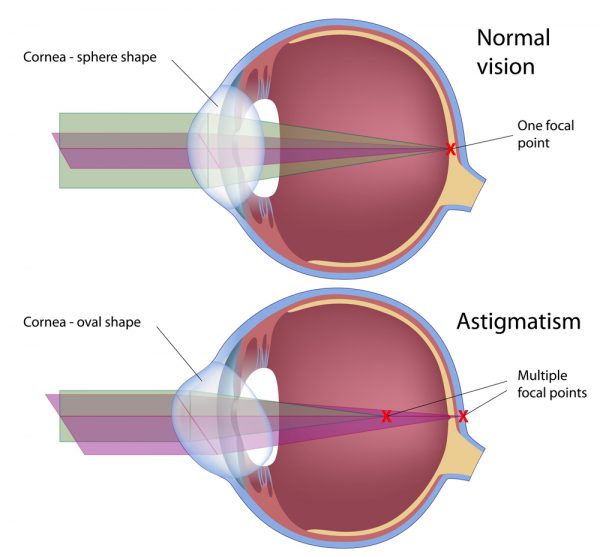Astigmatism
Millions of people have astigmatism, a condition which typically affects the cornea of the eye and causes blurry vision and distortion. Our board-certified ophthalmologists—Dr. Michael Sumsion and Dr. Sean Sumsion—offer state-of-the-art treatments for astigmatism that can correct the problem and significantly improve your vision. For patients who have cataracts in addition to astigmatism, our ophthalmologists can remove the cataract and perform the astigmatism correction in the same procedure.

- What Is Astigmatism?
- Astigmatism Correction Benefits
- Astigmatism Treatment Options
- Astigmatism Procedure
What Is Astigmatism?
In a normal eye, the cornea is round; however, an eye affected by astigmatism has an oblong, uneven curvature—similar to the shape of a football. This often causes light to not focus properly on the retina, making objects appear blurry. Astigmatism can occur in combination with other refractive errors, such as nearsightedness or farsightedness, and may affect both distance and near vision. Symptoms often include eye strain, headaches, and difficulty seeing clearly at night. This condition can be present from birth or develop over time, and it can vary in severity from mild to significant.
What Are the Benefits of Correcting Astigmatism?
Correcting astigmatism can greatly improve the clarity and sharpness of your vision by addressing the irregular curvature of the cornea or lens that causes blurred or distorted sight. With proper treatment—such as glasses, contact lenses, or refractive surgery—patients often experience enhanced visual comfort, making everyday tasks like reading, driving, and using digital devices easier and less straining. Clearer vision can also improve depth perception and reduce issues such as eye fatigue, headaches, and squinting.
For those choosing surgical correction, benefits may include long-lasting results and reduced dependence on corrective eyewear. By achieving more precise focus, patients often notice a boost in overall quality of life, increased confidence, and greater freedom in daily activities and hobbies. Regular eye exams are essential for diagnosing astigmatism early and determining the most effective correction method for optimal, lasting vision improvement.
What Treatment Options Can Address Astigmatism?
Limbal Relaxing Incisions (LRI)
Limbal Relaxing Incisions, or LRIs, can be used to treat minor astigmatism. This procedure involves the creation of small incisions around the iris to help the cornea reshape itself into a rounder curvature. LRI’s are often performed after cataract removal to reduce astigmatism and improve vision.
Cataract Surgery
Cataract surgery can address astigmatism by replacing the eye’s cloudy natural lens with a specially designed toric intraocular lens (IOL) that corrects the uneven curvature of the cornea. This advanced lens helps focus light more accurately on the retina, improving visual clarity and reducing or eliminating the need for glasses or contact lenses for distance vision. By treating both cataracts and astigmatism at once, patients can achieve sharper, more comfortable vision and an overall enhanced quality of life.
What to Expect from Astigmatism Correction Surgery?
- Length of Procedure: The exact length of time for astigmatism correction will depend on your unique needs, and whether you are combining astigmatism treatment with cataract surgery. LRIs can take as little as five minutes; while cataract surgery typically takes under 25 minutes.
- Who will perform my procedure?: Drs. Michael and Sean Sumsion, our experienced board-certified ophthalmologists, perform all surgical procedures
- How long will I need for recovery?: Recovery time will depend on the type of procedure you undergo; however, many patients are able to resume normal daily routines within about one day.
- Results: Our advanced astigmatism treatments can help you significantly reduce blurriness and visual distortion caused by this common condition. Results should be noticeable after one to two days, once the eye has been given enough time to heal from surgery.
Contact Riverside EyeCare Professionals
If you would like to learn more about treatments for astigmatism, or if you would like to schedule a consultation with one of our ophthalmologists, please contact Riverside EyeCare Professionals.